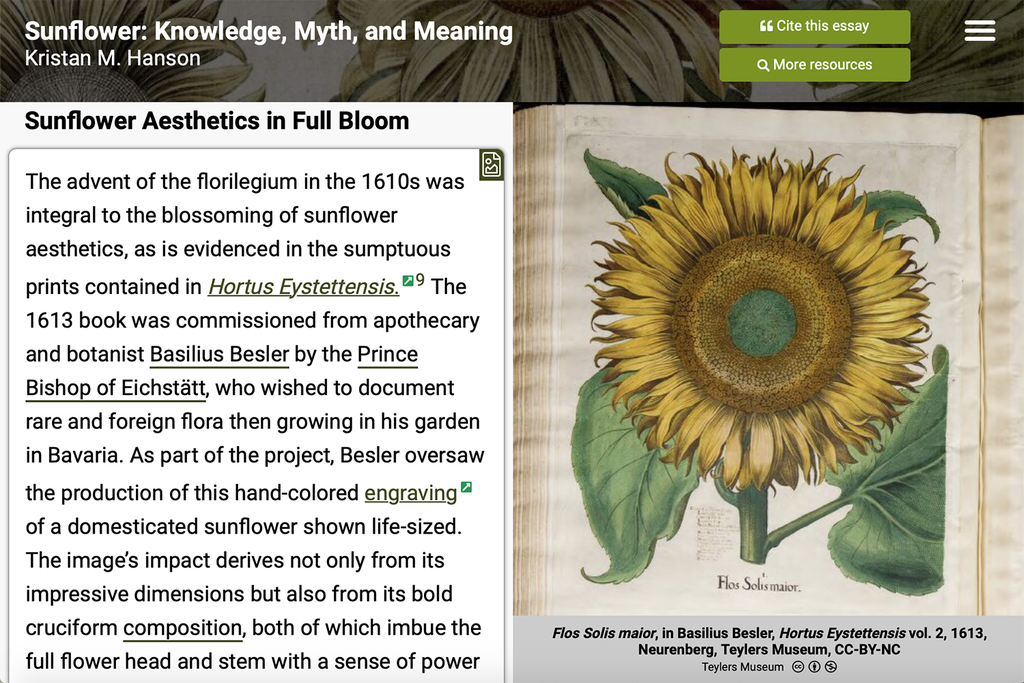By Ashley Buchanan
This summer, our Plant Humanities Initiative, funded by the Andrew W. Mellon Foundation, welcomed nine faculty members from across the country for our inaugural College Teacher Residencies. The group met virtually over two weeks to learn about, discuss, and grow the network of scholars engaging with the emerging field of plant humanities. Led by Yota Batsaki and Anatole Tchikine, the virtual residency program asserted the importance of the interdisciplinary study of plants. They also gave us the first strong indication of the pedagogical value of the Plant Humanities Lab, as part of our stakeholder engagement plan.
The Plant Humanities Lab is an open-source digital humanities project we developed with JSTOR Labs. Through interactive visual narratives connected to primary sources, the Plant Humanities Lab interprets, contextualizes, and historicizes plants in relation to human societies and to other flora and fauna in their environments. By leveraging the power of linked open data, the Plant Humanities Lab allows for the integration of a massive and visually engaging repository of primary and secondary sources, and provides a set of digital tools for students and researchers to learn and explore the possibilities of creative data visualizations.

The Plant Humanities Initiative seeks to support an emerging interdisciplinary field by creating an innovative and open-access digital platform, the Plant Humanities Lab, that introduces students and the public to important cultural histories of plants. Now in its fourth year, and with the successful launch of an innovative digital platform, the focus of the initiative encompasses how the lab can enhance humanities and science education and facilitate the creation of more diverse and inclusive classrooms.
Following the rollout of the beta version of the Plant Humanities Lab in March, we began working closely with educators and creating asynchronous training videos to introduce the lab and explore its adoption in informal and formal learning environments. We are particularly interested in how the tool can enhance the classroom experience of teachers and faculty by providing engaging alternatives to traditional texts, greater access to primary sources, and meaningful connections to historical themes and contemporary topics without adding to already heavy teaching loads.
To gain a broader perspective on the needs and challenges facing educators, we selected participants for our inaugural summer residencies at different career stages and from institutions ranging from community colleges to research universities. Due to the interdisciplinary nature of the Plant Humanities Initiative, we also felt it was important for participants to represent diverse academic disciplines. These included photography, environmental history, sociology, art history, biology, African American and diaspora studies, Latin American studies, and literature. Each participant’s distinctive disciplinary training and research interests reminded us of the value of the interdisciplinary approach. Writer Sumana Roy spoke to the poetry of plants’ being; historian of the African diaspora Alicia Monroe highlighted the spiritual significance of plants; and biologist Kyra Krakos provided insights on plants’ fascinating biology. Our conversations were one of the most enjoyable and enduring aspects of this virtual experiment, as knowledge, ideas, and pedagogical approaches flowed freely and enthusiastically among the group and new friendships and collaborations were formed.
In addition to fostering a network among faculty with diverse but connected interests in plants, the program sought to provide digital resources and training on the Plant Humanities Lab for use in the classroom. Participants spent several days learning how to navigate, use, and build their own visual narratives using Juncture, the visual essay tool that was developed for the Plant Humanities Lab. The goal of this training was to demonstrate how Juncture could be deployed in the classroom as a final project as well as being a means for students to gain valuable digital humanities skills and practice. Participants saw the Plant Humanities Lab as a way to promote active learning in the classroom, since it integrates traditional approaches with interactive data visualizations and facilitates engagement with primary sources.
The experience of the faculty residencies strengthened our conviction that the lens of plants can help us reach and inspire students from diverse backgrounds and majors. One participant remarked that “visual narratives on plants like sugarcane or breadfruit would be tremendously valuable from a pedagogical perspective for introducing histories of plants, enslavement, and diaspora to undergraduates.” The feedback we received is already informing the plant narratives we are working on this year, which include many plants key to histories of Indigenous knowledge, migration, and resilience, such as maize, sugarcane, peanut, and black-eyed peas. Stay tuned on future developments of the Plant Humanities Initiative through our monthly reports in the Oaks News as well as the Plant Humanities Initiative site and our Plant of the Month articles in JSTOR Daily.
Ashley Buchanan is a postdoctoral fellow in plant humanities.

